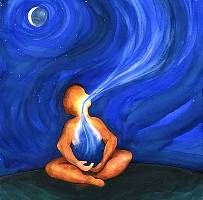 Dhyana is a Sanskrit word which means to meditate, derived from the verbal root dhyai, Dhyana it is the most common designation for both the meditative state of consciousness and the yogic techniques by which it is attained.
Dhyana is a Sanskrit word which means to meditate, derived from the verbal root dhyai, Dhyana it is the most common designation for both the meditative state of consciousness and the yogic techniques by which it is attained.
Dhyana is the seventh of Patanjali’s “Eight Limbs” of Raja Yoga (or classical yoga). Patanjali describes Dhyana as the repeated continuation, or uninterrupted stream of that one point of focus (Dharana) is called absorption in meditation (dhyana), and is the seventh of the eight steps (Yoga-Sutras 3.2).
There are two distinct stages that precede the practice of Dhyana. The first leads to sense withdrawal (Pratyahara), the second to concentration (Dharana), and finally, after these first two stages have been achieved, the yogi or student is prepared for the practice of true meditation (Dhyana).
Without such prior preparation, the efforts to concentrate the mind, often leads only to an inner and frustrating battle. The vrittis of chitta (fluctuations of the “mind stuff” or constant chatter of the mind) leads people to say they cannot meditate, and they intend to learn to meditate later. But the key is not to merely put off meditation practice until some future time, which never seems to come. Rather, the truth of the matter is that preparation is needed. With preparation, concentration and meditation arise naturally. Without the preparation, little or nothing of value happens.
The student is instructed to always to begin with concentration (Dharana), and then proceed to meditation (Dhyana), which finds fruition in Samadhi. This triple process is called samyama. During this process the yogi (or student) may become aware of higher powers (Siddhis) and become captivated by them, but Patanjali warns they are obstacles to the full or higher samādhi. Only by non-attachment to even these things, however great they may seem, may the seeds of bondage be destroyed, and independence or freedom attained.
In summary: Dhyana is the unbroken stream of concentration, where little to no “sense of self” remains. At this stage, it becomes increasingly more difficult to use words and reasoning (thoughts), or the conscious mind to describe these inner experiences of yoga. After all, the state of meditation, by its very nature transcends our material human experience and everything that is related to it. Meditation (Dhyana), is concentration (Dharana) taken to “perfection”; in other words, the meditative state is the natural consequence of “perfect concentration”. So it is by prolonged concentration, that produces this “spontaneous”, “free-flowing” meditative state, where nothing except the object of concentration fills the mind’s space; and where the observer and the observed merge into one.
If you are unfamiliar with meditation the following video (Andy Puddicombe: All it takes is 10 mindful minutes) may be helpful…
Related article, click on: The Eight Limbs of Yoga (Part 6 – Dharana)
Check back soon for “The Eight Limbs of Yoga (Part 8 – Samadhi)”
 Dharana is a Sanskrit word which means immovable concentration of the mind (or that which gives stability”) from the root Dhar, which means to “bind together”, “to make stable”. Dharanais the willful act of concentration of the mind.
Dharana is a Sanskrit word which means immovable concentration of the mind (or that which gives stability”) from the root Dhar, which means to “bind together”, “to make stable”. Dharanais the willful act of concentration of the mind.


 By controlling the act of breathing the student can efficiently and effectively control the various motions in the body and the different nerve currents that are animating the body. When practiced properly, one can easily and quickly gain control over body and mind through Pranayama, developing character and consciously harmonizing the individual’s life with the cosmic or Divine life.
By controlling the act of breathing the student can efficiently and effectively control the various motions in the body and the different nerve currents that are animating the body. When practiced properly, one can easily and quickly gain control over body and mind through Pranayama, developing character and consciously harmonizing the individual’s life with the cosmic or Divine life.